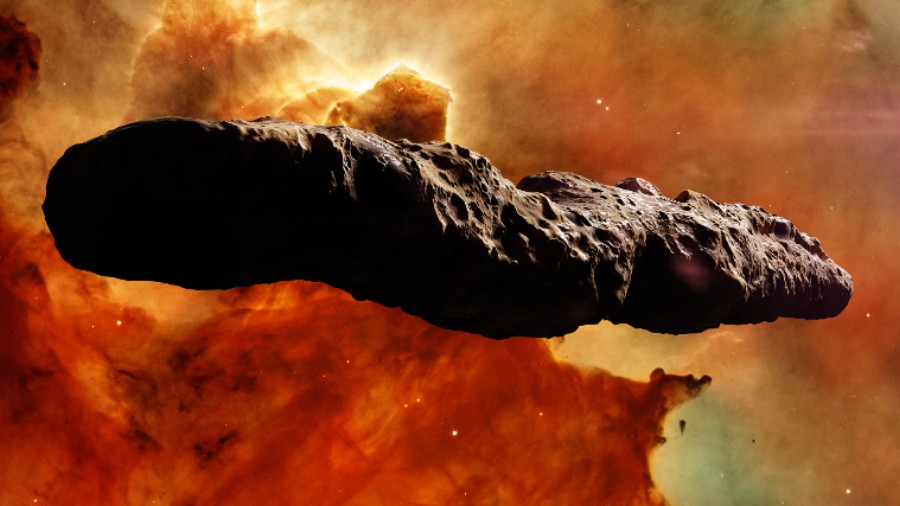One of the great shaggy-dog mysteries of the sky continues to mesmerise astronomers. That would be the nature of a strange interloper, Oumuamua, that came zooming through the solar system in 2017. Interstellar comet? Cosmic iceberg? Alien space wreck?
Last week two astronomers from Arizona State University in the US, Alan Jackson and Steven Desch, offered the most solid explanation yet: Oumuamua was a chip off a faraway planet belonging to another star. Long ago, a collision with an asteroid broke it off and sent it careering through space.
“This research is exciting in that we’ve probably resolved the mystery of what Oumuamua is, and we can reasonably identify it as a chunk of an ‘exo-Pluto’, a Pluto-like planet in another solar system,” Desch said in a statement released by the American Geophysical Union. “Until now, we’ve had no way to know if other solar systems have Pluto-like planets, but now we have seen a chunk of one pass by Earth.”
They announced their results at a meeting of the 52nd Lunar and Planetary Sciences Conference on March 17 and in a pair of papers in The Journal of Geophysical Research: Planets.
“What makes Oumuamua both interesting and frustrating is that none of the theories are a slam-dunk,” said Gregory Laughlin, an astronomer at Yale, US.
Astronomers in Hawaii first spotted this mystery object speeding away from the sun at 50 miles per second on October 19, 2017. They called it Oumuamua — Hawaiian for “scout” or “messenger”. But what was the message?
The trajectory of the object indicated that it had come from outside the solar system and that after a brief buzz past the inner worlds of our system, it was bound for deep space. By the time it was noticed, it had already passed Earth. Astronomers concluded from the variations in its brightness that it was a tumbling object, longer than it was wide.
Astronomers had long thought that an orphan comet might be the first interstellar visitor to our region because comets, residing in distant clouds, are easily detached from their home stars. Oumuamua did not have a tail, however, or the gaseous cloud that forms around a comet nucleus, so it was tentatively identified as a wandering asteroid.
An artist’s conception of a reddish, cigar-shaped rock gained widespread circulation. Some astronomers have suggested that it could be shaped like a pancake.
But when Oumuamua was on the way out of the solar system, it sped up. So perhaps it was a comet after all — but a weird one.
An international team of comet experts writing in Nature Astronomy in 2019 under the name of the Oumuamua ISSI Team concluded that all the data were consistent with “a purely natural origin” for Oumuamua.
Last year, Laughlin of Yale and his student Darryl Seligman, now at the University of Chicago, US, suggested that Oumuamua was a primordial iceberg of hydrogen that had formed in the dark, cold centre of a molecular cloud, one of the vast assemblages of primordial gas that give rise to stars.
The problem was that it was hard to explain how the hydrogen, which freezes at a temperature around 3 degrees Kelvin, barely above absolute zero, would stay frozen on the long trip from its birth to here.
Inspired by the hydrogen ice idea, Jackson and Desch investigated other kinds of ice-bergs that might fill the bill. They finally hit on nitrogen.
“We’ve never seen any examples of hydrogen ice in nature,” Desch said in an email. But when the New Horizons spacecraft went past the previously unexplored Pluto in 2015, it found a world awash in nitrogen glaciers.
“Oumuamua was small, about half as long as a city block and only as thick as a three-story building, but it was very shiny,” they wrote in one of their papers. “The shininess is about the same as the surfaces of Pluto and Triton, which are also covered in nitrogen ice.” Triton is a moon of Neptune.
In the scenario favoured by Desch and Jackson, the nascent Oumuamua was knocked from a Pluto-like object that was circling a distant star some half-billion years ago. It would have originally been roundish, but as it travelled through space it was carved away by cosmic rays.
Desch and Jackson concluded: “…Oumuamua is an example of an uncommon but certainly not exotic object: a fragment of a differentiated Pluto-like planet from another stellar system.”
In an email Loeb complained, among other things, that if Oumuamua was made of nitrogen it should also contain carbon (which was not detected by the Spitzer Space Telescope), because both nitrogen and carbon are produced by a thermonuclear carbon-nitrogen-oxygen cycle in stars.
Desch went on to note that planets have ways of sifting and separating the elements they were born with. He also pointed out that the reddish colour of Oumuamua is an exact match to the redness of the ice on Pluto, which is 0.1 per cent carbon, in the form of methane.
Another issue is statistics. How is it that these cosmic icebergs are so common — more than 50 trillion per cubic light-year of space, according to a calculation by Laughlin — that the Pan-STARRS project would have discovered one after just five years of searching?
“That puts a lot of pressure on the galaxy to manufacture exo-Plutos,” Laughlin said.
If so, Oumuamua was just the tip of an unsuspected iceberg, so to speak.
NYTNS











